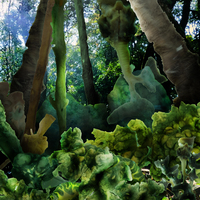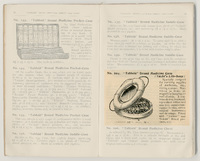Items
Site
The Medicine Chest
keywords is exactly
wind
-

A 'Jungle'
"A ‘jungle’ consisted of a selection of pathological specimens from the Pathology Learning Centre that had been affected by typhoid fever, ascaris adult worms, yellow fever, amoebic ulcerations, tuberculosis and malaria. The diseases that afflicted these specimens were regarded as ‘tropical’. As described in Chapter One, BWC used the jungle as a significant terrain that called for a medicine chest to combat pathogens: ‘Whether you were valiantly saving your compatriot in war, traversing a dark African jungle, navigating one of the world’s first flying machines, exploring the most desolate place on earth, ascending the highest mountain in the world, or simply enjoying the windswept British coast, the chest would be there, ready for any ailment’ (Johnson 2008b: 255). BWC promoted their chests as the ideal antidote for a tropical landscape ‘at once full of potential wealth for imperial Britain, but simultaneously rife with disease’ (Johnson 2008b: 258) and claimed that the tropical colonies were ‘by far the most dangerous regions for travellers’ (BWC 1934: 8). It was here that ‘desolating ailments’ were encountered, all ‘particularly fatal to the so-called white man who originates in temperate climates’ (BWC 1934: 8). I adapted the colour of the images of afflicted intestines, livers, stomachs and brains and used them as material to construct a dense jungle that referenced this aspect of the medicine chest’s history. Printed on separate glass sections that fit into the cabinet at spaced intervals to create an illusion of depth and three-dimensionality, the work draws on the cross-sectional display technique used in many anatomy museums worldwide, in projects such as the Visible Human Project (1995) and that the artist Damien Hirst references in his works . Creating a visual link between the UCT specimens and the history of these diseases surfaces the occluded racial undertones of these understandings" (Liebenberg 2021: 267). -

Navigation chart, Micronesia
"Early Pacific seafarers did not have scientific instruments or conventional European-style maps to voyage to, and settle, the thousands of islands of Micronesia and Polynesia. Instead they used the movement of the sea, the direction of the wind, the position of the sun and stars, and the flight of birds. This is a navigation chart, obtained by Georg Irmer, the Governor of the Marshall Islands from Chief Nalu of Jaluit atoll in 1896. The strips of wood, bound by cane, represent the currents and winds, and the six small, white shells represent islands". -

Diving the Tacoma Narrows Bridge
"All that debris still remains under the bridge for the most part, and it has become a dive site. It is a very difficult dive site to get to because of the swiftly moving water and the very short period of slack time. Nature in this area has just a tremendous ability to take over. You have a man-made structure like the Tacoma Narrow Bridge that collapsed into the water. Very quickly, the ocean took it over and made it part of the habitat". Extract from the voiceover of trailer for 700 Feet Down (a documentary about the Tacoma Narrows Bridge told through witnesses of the bridge’s 1940 demise as well as intrepid divers exploring a reef of wreckage, ultimately reflecting on how history influences the present) -

The Memory of Water
"Of the cases used during Stanley's famous travels, the "Rear Guard" 'Tabloid' Medicine Chest is worthy of special mention. The chest remained in the swamp regions of the Aruwhimi for nearly four years, and more than once was actually submerged in the river. Notwithstanding these mishaps, when the chest was brought back to London and the remaining contents tested by the Official Analyst of the Lancet, they were found to have retained their efficacy "(BWC 1934: 5). -

The Memory of Water
Of the cases used during Stanley's famous travels, the Rear Guard 'Tabloid' Medicine Chest is worthy of special mention. The chest remained in the swamp regions of the Aruwhimi for nearly four years, and more than once was actually submerged in the river. Notwithstanding these mishaps, when the chest was brought back to London and the remaining contents tested by the Official Analyst of the Lancet, they were found to have retained their efficacy (BWC 1934: 5). -

The Tacoma Narrows Bridge
The old Tacoma Narrows bridge was named Galloping Gertie because it vibrated rather strongly whenever there was a little wind due to resonance, the property which most objects have, of vibrating more strongly when exposed to an external force which is itself vibrating at the object's natural frequency. Crossing Gertie was actually quite a popular thing to do, similar to riding a roller-coaster. On November 7, 1940, things changed for the worse however. It was a day of rather high winds which caused Gertie to take on a 30-hertz transverse vibration with an amplitude of 1½ feet. This developed into a twisting motion of about 14 hertz, which then tore the bridge in two. The only victim of the disaster was a three-legged Cocker Spaniel, Tubby, left in the back seat of a lone car abandoned on the bridge.


